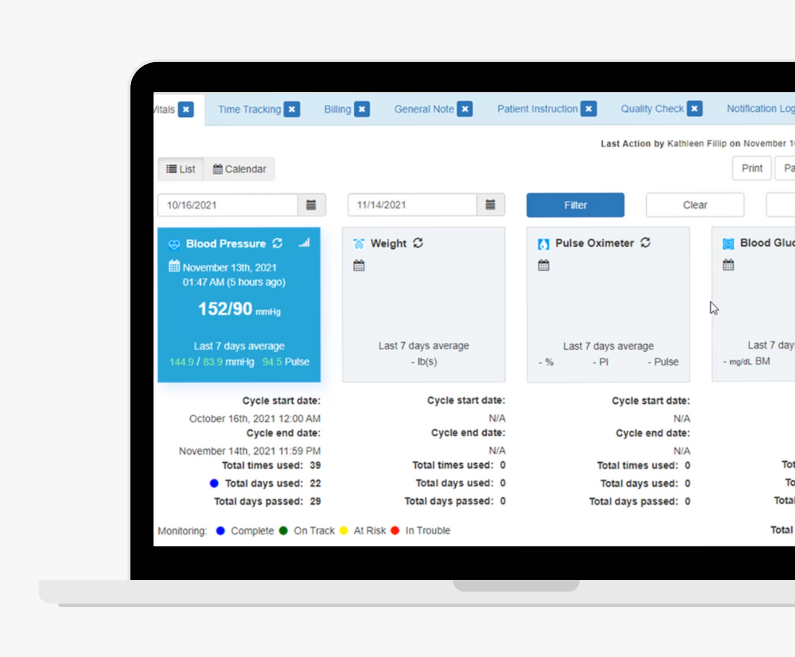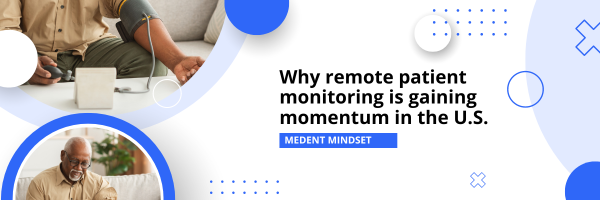April 26, 2023
In recent years, Remote Patient Monitoring (RPM) has become increasingly important in the United States. According to a survey conducted by Spyglass Consulting Group, 88 percent of healthcare providers in the U.S. are either currently using or planning to use RPM technology, and Grand View Research expects the RPM market to grow at a compound annual growth rate of 17.3 percent by 2027.
So why is RPM gaining such momentum?
RPM allows healthcare providers to monitor patients’ health status in real-time, outside of traditional clinical settings. This enables early detection of changes in a patient’s condition, which can lead to earlier intervention and better outcomes.
For example, RPM can detect changes in vital signs that may indicate the worsening of a chronic condition like heart failure, allowing doctors to adjust medications or recommend lifestyle changes before the condition becomes more severe.
RPM enables patients to receive care from the comfort of their own homes, which can be particularly beneficial for patients who live in rural or remote areas, or who have mobility issues. RPM can also reduce the need for in-person visits, which can save time and money for both patients and healthcare providers.
RPM has the potential to reduce healthcare costs by preventing hospitalizations, emergency department visits, and other costly interventions. For example, by monitoring patients with chronic conditions like diabetes or hypertension remotely, healthcare providers can intervene early and prevent complications that may require hospitalization.
RPM can increase patient engagement and self-management by providing patients with access to their own health data. Patients who are actively involved in their care tend to have better outcomes and are more satisfied with their care.
In fact, according to a survey conducted by the Consumer Technology Association, 74 percent of patients who used RPM technology reported feeling more connected to their healthcare provider, and 71 percent reported feeling more in control of their health.
In the U.S., the Centers for Medicare and Medicaid Services (CMS) offers reimbursements for certain RPM services, providing an additional incentive for healthcare providers to adopt RPM. In 2020, CMS expanded the list of eligible services, making it easier for healthcare providers to receive reimbursement for RPM.
As technology continues to evolve, RPM has the potential to revolutionize the way healthcare is delivered and improve patient outcomes.
There are currently various types of devices that can be used to monitor and manage a wide range of chronic conditions. Here are some chronic conditions that typically benefit from RPM:
RPM can help patients with diabetes manage their blood sugar levels by monitoring their glucose readings, medication adherence and lifestyle factors such as diet and exercise. Blood glucose meters are used to monitor blood glucose levels in patients with diabetes.
A study published in the Journal of Diabetes Science and Technology found that patients with diabetes who used RPM had better blood sugar control and lower HbA1c levels compared to those who did not.
RPM can help patients with high blood pressure monitor their blood pressure readings, medication adherence and lifestyle factors such as salt intake and physical activity. Blood pressure monitors are used to monitor blood pressure levels in patients with hypertension or other cardiovascular conditions.
A study published in the Journal of Clinical Hypertension found that patients with hypertension who used RPM had better blood pressure control and medication adherence compared to those who did not. Patients reported feeling more motivated to manage their condition and appreciated the personalized support from their healthcare providers.
RPM can help patients with heart failure monitor their weight, blood pressure, heart rate and symptoms such as shortness of breath or swelling in the legs. ECG monitors measure the electrical activity of the heart and are used to monitor patients with cardiovascular conditions.
A study published in the Journal of Medical Internet Research found that patients with heart failure who used RPM had lower rates of hospitalization and emergency department visits compared to those who did not use RPM. Patients reported feeling more confident and secure in managing their condition.
RPM can help patients with COPD monitor their lung function, oxygen saturation and symptoms such as shortness of breath or coughing. Spirometers measure lung function and are used to monitor patients with respiratory conditions such as asthma or COPD. Pulse oximeters are also commonly used to measure the oxygen saturation levels in a patient’s blood.
A study published in the Journal or Telemedicine and Telecare found that patients with COPD who used RPM had improved lung function and fewer exacerbations compared to those who did not. Patients reported feeling more in control of their condition and appreciated the convenience of not having to travel to a clinic for monitoring.
RPM can help patients with chronic kidney disease monitor their kidney function, blood pressure and medication adherence. Wrist, arm and digital blood pressure monitors can be used to monitor high blood pressure, which is a common complication of kidney disease. Fingerstick meters and continuous glucose meters can also be used to monitor blood glucose levels, as diabetes is a common cause of kidney disease.
RPM can be used to monitor patients with mental health conditions such as depression or anxiety by tracking their mood, sleep patterns and medication adherence. Wearable Devices like smartwatches, fitness trackers and health monitors can be used to measure a patient’s vital signs, activity levels and sleep. There are also specific devices designed for mental health monitoring, such as mood tracking apps, cognitive behavioral therapy (CBT) apps and virtual reality therapy apps.
Weight scales and thermometers can also come in handy when monitoring a patient’s condition, as weight changes or fever can indicate there is an infection or other significant change in health status. Overall, the type of device used in RPM depends on the specific condition being monitored and the patient’s individual needs.
How MEDENT and FocusMD Can Help
Powered by FocusMD, MEDENT’s HealthxSolutions interface lets practices import vitals information from RPM devices into a patient’s chart. There are three RPM solutions a practice can choose from:
-
Practice Evaluation
-
Patient Engagement
-
RPM Software & MEDENT Integration
-
Practice Evaluation
-
Care Management via FocusMD nurses
-
Patient Engagement
-
RPM Software & MEDENT Integration
-
RPM Software & MEDENT Integration
How It Works
Full Engagement
Run MEDENT Reports
Using MEDENT’s DMHM reports, FocusMD checks to see if the patient has had an appointment within the past 12 months and if they have an upcoming appointment.
Contact Patient & Alert office
FocusMD contacts the patient directly and adds an alert to their MEDENT chart, which states that the patient meets RPM criteria and recommends an appropriate device.
ORDER DEVICE & Start tracking
Scan the device’s barcode to instantly import its information into the patient’s chart. Devices are cellularly connected so vitals data and notes will flow directly into MEDENT.
Once an order is created, it flows directly into the FocusMD RPM Dashboard where nurses from FocusMD can monitor all patients.
A FocusMD representative will educate each patient on how to use the different devices and care managers will reach out to patients at least 20 minutes each month and ensure patients are using the device at least 16 days a month to meet criteria for billing.

Reduction in 30-day hospital readmission rate for Heart Failure, COPD and Diabetes.
Source: Advisory Board
Don't Miss Our Next Workflow Webinar!
On Wednesday, May 17 at 12 p.m. EST, see how MEDENT can help practices track real-time vitals data to provide continual care and increase revenue. Plus, learn about our HealthxSolutions interface with FocusMD!

Comments are closed